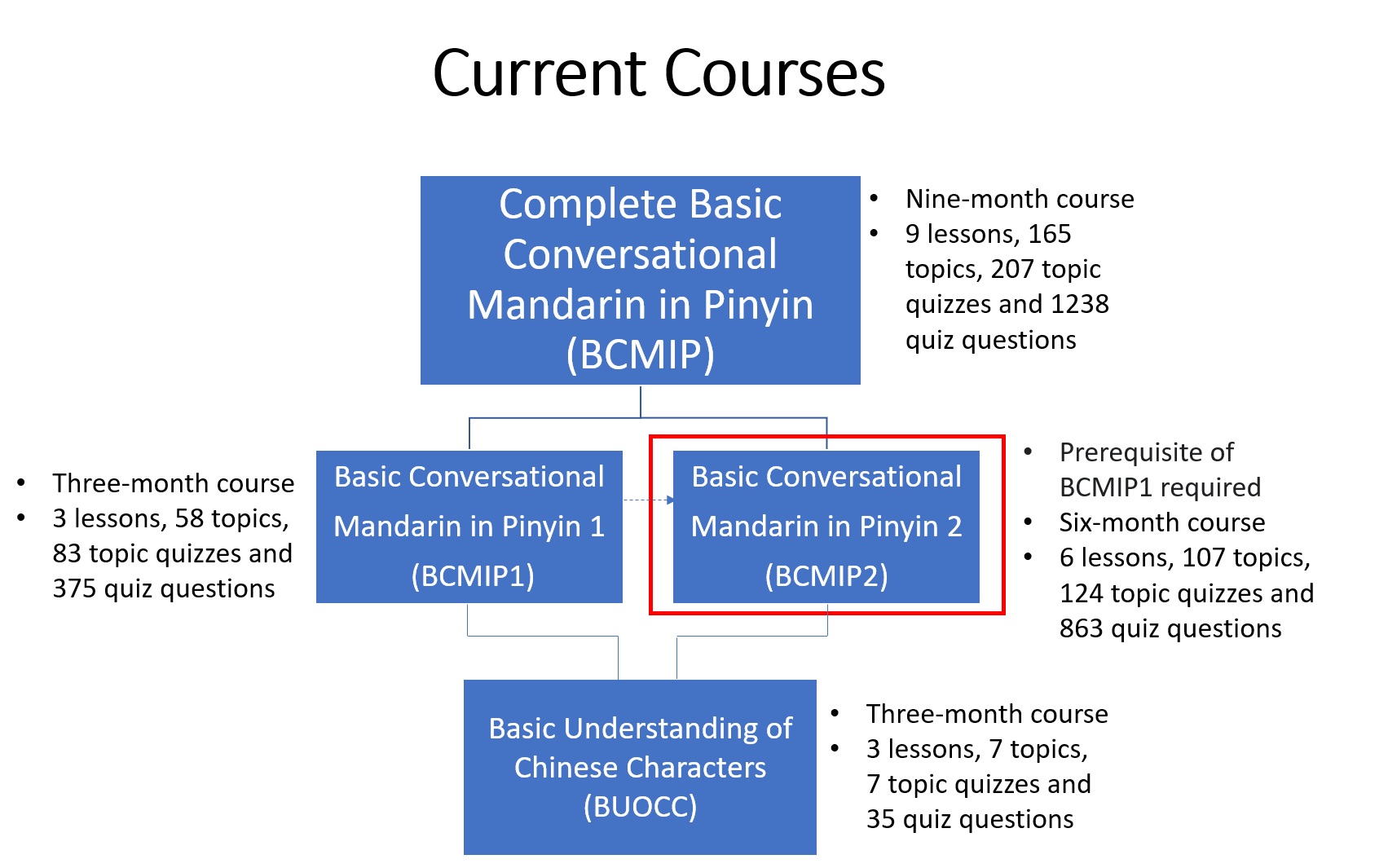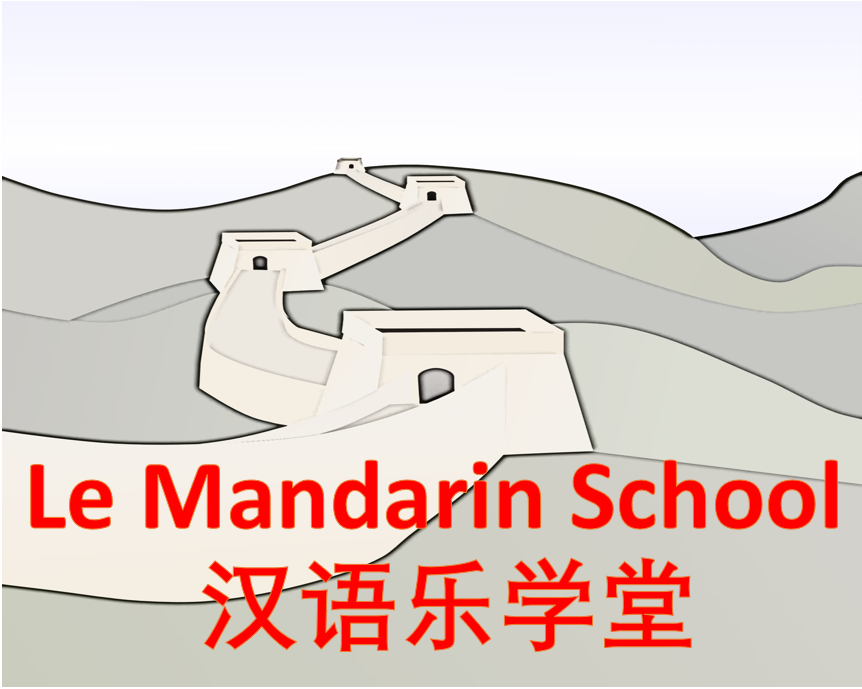Mandarin Language
LE Mandarin School...where learning is Enjoyab-LE!
Your Mandarin journey begins here.

Features



An E-learning system that makes learning Mandarin productive and effective
Learn Mandarin with a proven e-learning methodology that allows a flexible time schedule which caters for those who want to learn at a measured pace The ITs tool used will facilitate a conducive learning environment.
- Flexibility of taking the lessons as they are available 24x7.
- Quizzes at the end of every topic to ensure the student has understood the content before proceeding to the next topic.
- Instructor has more time to interact with students and monitor their performances as lessons are recorded.
- Both student and the Instructor has more time to interact via tools like video calls, messaging, forums etc to facilitate effective learning. There are knowledge bases for lessons which will facilitate learning too.

Current Courses
- Pinyin means “spelling sound” in Mandarin, and it is the method of pronunciation practised in China.
- You can also pay in Euro or SGD by switching currency on the cart page or checkout page.
- You must register first before making payment. To register, email your interest by using above Contact LeMS page.
Basic Conversational Mandarin in Pinyin 1 (BCMIP1) aka
BCMIP (Elementary)
US$78
US$39
Current Promo : 50% discount
- Learn Pinyin In Three Months
-
- 3 lessons, 58 topics
- 80+ topic quizzes
- 370+ quiz questions
- Includes 1 grammar lesson - e-Learning tools (video calls, messaging etc.)
- Lesson materials are also provided
- Recommended for:
- - Beginners
- - Those who need to have a refresher course.
Basic Conversational Mandarin in Pinyin 2 (BCMIP2) aka
BCMIP (Advanced)
US$145
US$99
Current Promo : ~30% discount
- *Prerequisite of BCMIP1 is required
- Six-month course
-
- 6 lessons, 107 topics
- 120+ topic quizzes
- 860+ quiz questions
- Includes 5 grammar lessons - e-Learning tools (video calls, messaging etc.)
- Lesson materials are provided
- Recommended for:
- - The practice-focused learning of this course will lay a solid grounding in speech/listening for the student before one learns written characters.
- - Students who want to apply Pinyin in daily conversation without the need to learn Chinese characters.
Basic Understanding of Chinese Characters (BUOCC)
US$98
US$49
Current Promo : 50% discount
- *Prerequisite of knowing Pinyin is required
- Learn Chinese Characters In Three Months
-
- 5 lessons, 7 topics
- 7 topic quizzes
- 35 quiz questions - e-Learning tools (video calls, messaging etc.)
- Lesson materials are also provided
- Recommended for:
- - Beginners
-
- Those who want to learn and write Chinese characters via a systematic appraoch.
- - Anyone who wants a refresher course.
Bundle Deals
Common FAQ

Note that BCMIP1 and BCMIP2 are sub-courses of BCMIP as depicted above.
Below are the available course combinations:
- BMCIP1 followed by BUOCC
- BCMIP1 first, followed by BUOCC and BCMIP2 respectively
- Complete BCMIP courses (BCMIP1 and BCMIP2) if you do not intend to learn Chinese characters
- BUOCC as a standalone course if you already know Pinyin
Some recommendations after you have completed trials at BCMIP1 and BUOCC:
- If you are a beginner or someone who wants to improve your pronunciation, you can select BCMIP1.
- If you think you want to practice more on Pinyin or apply it in daily conversation without the need to learn Chinese characters, then you can select BCMIP2 after finishing BCMIP1. In this case, then you can select BCMIP1 + BCMIP2 package as you will enjoy some cost savings compared to taking both BCMIP1 and BCMIP2 separately.
- You can sign up for the complete package of BCMIP1, BCMIP2 and BUOCC for maximum cost savings.
Lesson 1 Topics (T stands for Topic) This lesson serves to give the student an introduction to Chinese language and the tones.
- T1 – Understand the nature of Chinese Language
- T2 – Why Pinyin (Spelling Sound)
- T3 – Learn the Four Tones
- T4 – How to use Pinyin effectively
Lesson 2 Topics Lesson Two is a practicum-oriented topic as the student has to go through 30 topic videos and 53 quizzes before he/she can proceed to Lesson Three. The student is taught the traditional method of pronunciation and an alternative for those who prefer English-like pronunciation.
- T1 – English Proxy Sound Method for learning initials (An Alternative to Pinyin)
- T2 – Pinyin Pronunciation
- T3 – Practice
Lesson 3 Topics From this lesson onwards, the student will start to apply what they have learnt in Lessons 1-2. Simple Chinese grammar is also taught. The student is expected to say simple sentences like “I am an American”, “I am tall” etc.
- T1 – Vocabulary
- T2 – Basic word order (subject-verb-object)
- T3 – to be (shì)
- T4 – Adjectival verb
- T5 – yes-no question (ma)
- T6 – yes-no question (verb-not-verb)
- T7– Implied comparison
- T8 – Omitting known information
- T9 – Dialogue Practices
Lesson 1 Topics Student will learn how to introduce himself/herself in this lesson. He/she will also learn how to pronounce numbers from one to ninety-nine. There is a Course Interim Quiz at the end of this lesson.
- T1 – Vocabulary
- T2 – Classifiers
- T3 – Demonstrative Pronouns (this, that)
- T4 – Numbers I (one to ninety-nine)
- T5 – Possession (de)
- T6 – Tag Questions
- T7 – Naming in Mandarin/How to introduce yourself
- T8 – Dialogue Practices
- Course Interim Quiz
Lesson 2 Topics Lesson 5 will topics such as model verb ‘can’ and common adverb dōu to the student. He/she will complete the lesson on numbers and know how to apply them in real life.
- T1 – Vocabulary
- T2 – Numbers II (Hundred bǎi, Thousand qiān, Ten Thousand wàn)
- T3 – Zero (Líng)
- T4 – How many?
- T5 – Modal Verb ‘Can’
- T6 – Common Adverb dōu (all/both)
- T7 – Choice Questions (hái.shi)
- T8 – Follow-up questions with ne
- T9 – Dialogue Practices
Lesson 3 Topics This topic is important as it focuses on money and prices which every foreigner will need to use them in daily life when they are living in China. We will also look at numerical expressions like bàn, duō etc.
- T1 – Vocabulary
- T2 – Money and Prices
- T3 – Unit price
- T4 – Half (bàn)
- T5 – Something plus (duō)
- T6 – Each /Every (měi)
- T7 – “Only” (zhǐ)
- T8 – Must (děi, negation – bùbì)
- T9 – Change in situation using le
- T10 – Dialogue Practices
Lesson 4 Topics This is another essential lesson as the student will get acquainted with the calendar expressions.
- T1 – Vocabulary
- T2 – Year, Seasons
- T3 – Months
- T4 – Days of the Month and Time Ordering
- T5 – Days of the Week
- T6 – Parts of the day
- T7 – Last, This and Next
- T8 – Ordinal Numbers
- T9 – Dialogue Practices
Lesson 5 Topics Lesson Eight will wrap up the course by looking at time expressions and colours.
- T1 – Vocabulary
- T2 – Clock Time
- T3 – Common Time Expressions
- T4 – Completion Marker le
- T5 – Past/Present/Future
- T6 – Before/During/After of an action/event
- T7 – Verbal Duplication
- T8 – Colours
- T9 – Dialogue Practices
Lesson 6 Topics This is a summary lesson to highlight the important points in the course. The student will finish the course once he/she completes the Course Final Quiz.
- Summary of Key Points of this course
- Tips for self-learners who want to proceed further
- Course Final Quiz
What do I learn from the BUOCC course?
Lesson 1 Student will learn the below topics:
- An introduction to the history of Chinese characters
- 11 basic Chinese strokes
- How to count no. of strokes
Lesson 2 This lesson will allow the students to understand the structures of Chinese characters which facilitate a building-block approach for easier memorisation.
- An introduction to Chinese characters
- Understand the written rules
- Learn the 13 structures for Chinese characters
Lesson 3 Students will be taught radical to aid memorisation and also how to use it in a dictionary:
- Radicals are taught in this lesson.
- Learn how to use radicals to find out the meanings and pronunciations of Chinese character using a hardcopy dictionary.
- An online dictionary is also taught to help students to harness useful features that are missing in the hardcopy dictionary.
Lesson 4 Student will learn the below topics:
- Learn how Chinese characters were created. Such understanding will help the student to focus on certain characteristics of Chinese characters to aid memorisation.
- Student will learn there are six types of Chinese characters.
Lesson 5 The topics are:
- Studying some common radicals to understand how students can leverage this aspect for their learning. The method is to teach the students to use radical as a visualisation tool which will be easier to understand and thus there is no need to do rote learning.
- One approach in this lesson is for the student to refer to oracle bone script of the radical which is pictorial and therefore facilitates learning.
- Another approach is for the student to use his/her imagination to adapt the radical for better memorisation.
There is no refund policy as you can try out the sample lessons below to determine whether the course meets your expectations:
There are also free trials being offered currently.
Each course has a long duration of a few months to cater for busy people such as working adults. Setting an expiry date will encourage the student to commit his/her time in learning and so they do not procrastinate which is often a problem with lifetime access for a course.
The students can also download the lesson materials which will be useful for them even after the course has expired.
Access here for the complete FAQ.
Testimonials


Any questions?

Contact Le Mandarin School at this page!

